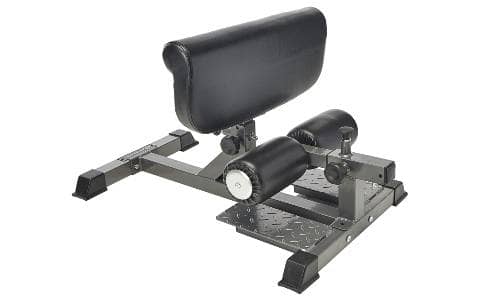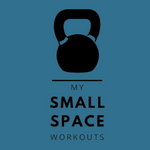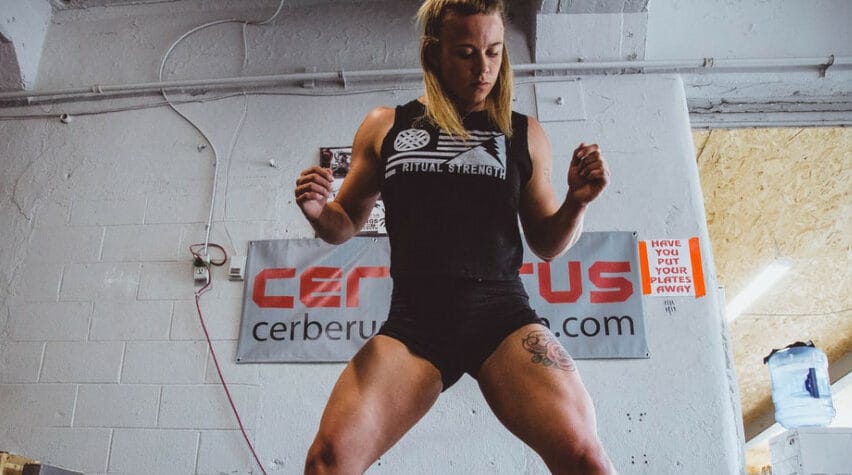It is possible to build big legs with kettlebells. However, it requires careful structuring of your workouts to ensure that you adequately stimulate each of the major muscle groups within the legs. You’ll also need a willingness to hit some high rep-counts to keep the volume high and compensate for the lack out outright weight lifted.

Disclosure: Just a heads up, as an Amazon Associate I may receive a small commission on any purchases made through links in this article. But don’t worry, we won’t let that cloud my judgement when it comes to recommending the best accessories to pair with your kettlebells. I promise to only suggest products that we believe will truly enhance your leg day workout. So go ahead and treat yourself to a new piece of equipment, and know that you’re helping support us in the process. Thanks for your support, and happy lifting!
Build Big Legs Fast
Following a well structure kettlebell leg routine, consistently, over a three-month period will lead to noticeable gains in your leg musculature.
In the Spring of 2020, I was recovering from severe gastritis caused by a hiatus hernia. The illness had become so severe that I had been unable to eat full meals and my body weight had crashed from 175 lbs to 130 lbs. As the world moved into lockdown in the face of the Covid pandemic, I was, ironically, starting to feel stronger and ready to start building some muscle.
My legs have always been a lagging body part in terms of development, but after such a severe bout of illness, they looked like pipe cleaners!
As my health improved and I followed a new home workout regime, I was delighted to find that by June my legs had responded incredibly well and my thighs were filling my trousers.
So it took 3 months to add some noticeable size to my thighs. Of course, I had the benefit of muscle memory but I’d not been eating particularly well (due to the hiatus hernia) and still managed to make good gains. What had changed from my previous workout regime? Kettlebells.
Strong Legs Without Squats
I’d had some kettlebells for years, but had really only used them for goblet squats as a finisher exercise within a barbell focused leg workout. During lockdown, I’d been training in my house as opposed to the garage and was focused on full body workouts, often using kettlebells.
These types of workouts tend to feature a variety of different exercises and get you moving in many different ways.
I believe that it was the wider variety of movements that had better engaged the quads, hamstrings, glutes and calves which had resulted in improved muscle mass.
During this period, I didn’t perform ANY barbell squats at all and by the Autumn of 2020, my legs were in the best shape they’ve ever been in.
Which Leg Muscles Can I Target With Kettlebells?
You can target all of the major muscle groups within the legs:
- The Quads
- The Glutes
- The Hamstrings
- The Calves
One of the many benefits of training your legs with kettlebells is that they encourage you to master the form for exercise performed. This can help in strengthening the mind-muscle connection ensuring that each rep focuses intensely on the targeted muscle.
Kettlebell training can also help you overcome (or work within) the limitations of any lack of flexibility or mobility that you may be suffering from.
For instance, my back squat form has never been good as I tend to lean forward more than I realise. I’ve always found front squats to be awkward too because of poor wrist, knee and ankle flexibility.
Goblet squats with a kettlebell have been a game-changer as I find that I can squat deeply, maintaining good form and keeping my quads under tension throughout the entire range of movement.
This means that not only can you target all of the leg muscles with kettlebell training, but you may also be able to achieve better results if you find that you’re able to perform the kettlebell exercises with better form than you can with their barbell counterpart.
Kettlebell Leg Workout
I believe another contributing factor to the dramatic increase in leg size and strength that I experienced when switching to kettle bell training was the frequency of training.
In my barbell routine I would hit legs three times in every two week period however during my lockdown regime I would hit legs three times per week.
A further factor may have been the shift in emphasis to unilateral leg exercises. I enjoy working legs this way as you maximize the effect of the kettlebell weight when working on a single leg.
The following leg workout can be performed two to three times per week. It should take less than half an hour to complete and will hit all the muscles of the leg.
If you’re new to exercise, perhaps start with just one round of each phase and add a round every two weeks until you can complete the workout as stated.
It is structured as a circuit to be completed in rounds of 40 seconds work / 20 seconds rest. This means that it can be completed in under 30 minutes.
| Set | Exercise | Muscle Targeted | Work | Rest | Rounds | Total time |
| 1 | Kettlebell Swing | Glutes / Hamstring | 0:00:40 | 0:00:20 | 3 | 0:12:00 |
| 2 | Kettlebell Squat | Quads | 0:00:40 | 0:00:20 | ||
| 3 | Kettlebell Sumo Deadlift | Hamstring | 0:00:40 | 0:00:20 | ||
| 4 | Calf Raises | Calves | 0:00:40 | 0:00:20 | ||
| REST | 0:01:00 | 0:01:00 | ||||
| 5 | Squat to Alternating Rear Lunge | Quads / Glutes | 0:00:40 | 0:00:20 | 3 | 0:15:00 |
| 6 | Kettlebell Jump Squat | Quads | 0:00:40 | 0:00:20 | ||
| 7 | Kettlebell Walking Lunges | Quads / Glutes | 0:00:40 | 0:00:20 | ||
| 8 | Weighted Glute Bridge | Glutes / Hamstring | 0:00:40 | 0:00:20 | ||
| 9 | Calf Raises | Calves | 0:00:40 | 0:00:20 | ||
| TOTAL TIME | 0:28:00 |
Supercharge Your Kettlebell Leg Workouts with These Top Training Accessories
If you’re looking to take your leg day workout to the next level, using kettlebells in conjunction with other equipment can help you achieve even better results. Here are some of the top training accessories to consider pairing with your kettlebells:
1. Sissy Squat Machine
The sissy squat machine is a piece of equipment designed to target the quadriceps muscles. It is ideal for those who want to increase the range of motion during squats and activate the front of their thighs effectively.
When combined with kettlebells, the sissy squat machine can make for a killer leg workout. Try performing sissy squats with a kettlebell in a goblet position or holding two kettlebells at your sides to add extra resistance to the movement.
If you’re new to the sissy squat machine, start with body weight squats and gradually increase the resistance with a kettlebell over time as you become more comfortable with the movement.
Element Fitness Sissy Squat Machine

- Targeted muscles: The Element Fitness Sissy Squat Machine targets and strengthens the quadriceps and glutes for a comprehensive leg workout.
- Comfortable: The machine’s design offers comfort and support for your knees and ankles during the exercise, reducing the risk of injury.
- Space-saving: The compact design of the Element Fitness Sissy Squat Machine makes it easy to store in a home gym or small workout space.
2. Nordic Curl Strap
The Nordic curl strap is another accessory that can help take your kettlebell workouts to the next level. It is a strap that attaches to a horizontal bar or frame and is used to perform the Nordic hamstring curl.
This exercise targets the hamstring muscles, helping to improve your overall leg strength and stability. When combined with kettlebell exercises such as goblet squats or lunges, the Nordic curl strap can provide a well-rounded workout for your legs.
Again, start with body weight and gradually increase the resistance over time as you become more comfortable with the movement.
COFOF Nordic Hamstring Curl Strap

- Easy Adjustment: Heavy duty mountaineering grade buckle improves safety and allows for easy adjustment in 5 seconds.
- Versatile Workouts: Can be used for various exercises to increase hamstring strength, improve knee stability and recover from hamstring problems.
- Compact Design: Easy to set up, carry and practice at home or gym with door anchor and adjustable strap length to fit all sizes.
3. Squat Wedge Blocks
Squat wedge blocks are small triangular-shaped blocks that can be placed under your heels during squats or lunges. They help to keep your feet stable and ensure proper form during the exercise.
When used in conjunction with kettlebell squats or lunges, squat wedge blocks can help to target your glutes and quads effectively. They also help to prevent injury by ensuring that your form is correct.
Try using a heavier weight kettlebell when using squat wedge blocks, as the added resistance will help to further target your leg muscles.
Gym Docs Squat Wedge Block

- Knee protection: The Gym Docs Squat Wedge Block offers support for your knees during squats, reducing the risk of injury and discomfort.
- Form enhancement: The wedge design promotes proper form during squats, enhancing the effectiveness of your workout.
On-the-go: With its lightweight and compact design, the Gym Docs Squat Wedge Block is ideal for those who like to workout on-the-go or in any gym or workout space.
4. Plyometric Platform Boxes
Plyometric platform boxes are often used for jump training and can be a great addition to your kettlebell leg day workout. They come in different sizes and can be adjusted to various heights, making them a versatile piece of equipment.
Plyometric exercises such as box jumps can help to improve your explosive power, speed, and agility. When combined with kettlebell exercises such as the box step up can provide a challenging workout that will help to improve your overall leg strength and conditioning.
When using plyometric platform boxes, start with a lower height and gradually increase the height over time as you become more comfortable with the movement and find yourself able to step up to the taller boxes.
VEVOR Plyometric Platform Box 12/18/24 Inch

- Versatile: The VEVOR Plyometric Platform Box set can be used for a variety of exercises, including jump training, plyometrics, and more.
- Durable: Made with high-quality materials, this plyometric box set is built to last and can withstand the wear and tear of intense workouts.
- Multiple sizes: With three different sizes (12″, 18″, and 24″) included in the set, you can progress and challenge yourself as you improve your fitness level.
What Kettlebell Weight To Buy

If you don’t currently own any kettlebells and are looking to buy your first one, then you’re probably wondering what weight to buy. My advice would be to start with a light kettlebell (18lb/8kg or 26lb/12kg) as you will need to master the basics of kettlebell training, before building up to bigger weights.
You will probably find that you’re ready to upgrade your kettlebell after as little as a month of training, but look upon this is a positive thing. I have found great benefits in having numerous different weights of kettlebells in my fitness inventory. One benefit is the ability to perform drop-sets (consecutive lighter sets with no rest in between) so that you can work out to failure.
Here is a selection of kettlebells that are available from Amazon.
Maximising The Gains
Before you begin your workout, you may want to check out this article where I share a secret to maximising your gains.



I was wondering if I could build big legs with kettlebells. And I conclude that no matter what tool I use, it could be my own body, barbell, dumbbells or kettlebells, one way to elicit muscle mass growth is through progress overload. Aside from using a heavier bell, this seems to be a pretty easy way to increase the amount of stress on the muscles to promote growth.
Absolutely Paolo. Progressive overload is THE core driver for muscle growth! Thanks for reading.
Wao, a detailed explanation of how to build big legs with kettlebells. I like this and, in particular, building the core without breaking my back.
A very informative article, removing the myth from bodybuilding. I have always wanted to dabble into it, but I am very cautious about how much pressure I put on it since I had issues with my back.
Thanks for your comment. As you can tell, I love kettlebells. If you’re going to try this workout, it would be a great idea to speak with a doctor and a physiotherapist first in light of your back issues! Good luck!
Really great tips on how to build big legs with kettlebells. A very detailed explanation of the exercises, how to perform them, how long to perform them and how much to rest, and which muscles we target. This table is nicely transparent and a good framework for the daily goal. Thanks!
I currently have some dilapidated kettlebells at home, I will try them out in these exercises, and I will also consider buying new ones soon.
I wish you all the best
Nina
That’s awesome Nina! Just remember that if you’ve not exercised in a while, you needn’t do all the rounds!